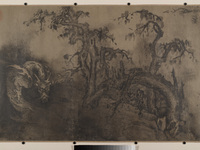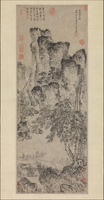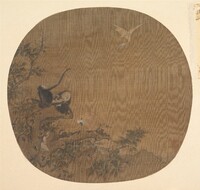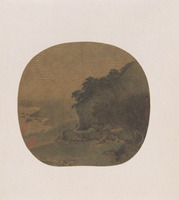Search
140 items
-
Crooked Pine
老松圖Artist’s inscription and signature (2 columns in cursive script) In winter, the eleventh lunar month of the third year of the Yuantong reign era [1335], while visiting the Cloud Grotto, I saw a crooked and twisting ancient pine. Thereupon I brushed this picture to record what I saw. An ink-play by Meihua Daoren [Wu Zhen].[1] 元統三年冬十一月因游雲洞見老松屈曲,遂寫圖此,以紀其所見也。梅花道人戲墨。 Artist's seals Meihua An 梅花 Jiaxing Wu Zhen Zhonggui shuhua ji 嘉興吳鎮仲圭書畫記 [1] Translation from Wen C. Fong. Beyond Representation: Chinese Painting and Calligraphy 8th–14th Century. New York: The Metropolitan Museum of Art, 1992, p. 446. Modified. -
Crows in Old Trees
古木寒鴉圖No artist’s signature or inscription Artist's seals Luo shi Zhichuan 羅氏稚川 Youxi hanmo 遊戲翰墨 -
Dragon and Landscape
雲行雨施圖Artist’s inscription and signature (1 column in seal script, apocryphal, on tree trunk) Produced by Suoweng [Chen Rong]. 所翁製。 -
Dragon Boat Regatta on Jinming Lake
金明池圖Artist’s signature (1 column in clerical script, undated): Servitor Wang Zhenpeng 臣王振朋 Artist’s colophon (18 columns in clerical script, dated 1323): In the Chongning reign era [1102–06], the Jinming [Golden Bright] Lake used to be opened on the third day of the third lunar month and prizes were offered so that the citizens could share its pleasure with the monarch. This is described in detail in the Dreams of the Splendor of the Eastern Capital [Menghua lu by Meng Yuanlao]. In the gengxu year of the Zhida reign era [1310], it happened to be the “Festival of a Thousand Springs” [i.e., the royal birthday] of his imperial highness, the heir-apparent, the future emperor Renzong, when I did a painting depicting this subject for presentation [as a birthday gift]. I inscribed on the painting the following poem: On the third day of the third lunar month the Golden Bright Pond was bustling with games of the giant dragon boats, Amidst the thundering applause and cacophony of drumbeats and music. The aura of joy was radiant as the sun and brightened the flags and banners. Although the prizes could not be worth much, the river-boys from the Wu District Were heedless in the height of their ecstasy. They remind us of all the foolish competitors of the world Who strive forward by inches and backward by feet. But what actually counts is the idea of shared pleasures with the entire populace. For that reason alone, I dare to compose this piece of ‘soundless poetry’ [painting]. The Heir-apparent leads a simple life and indulges himself in no excesses. In the garden of the arts and the forest of books alone, he enjoys himself with spiritual and visual pleasures. Today on the occasion of his royal birthday, I respectfully record this for posterity – As a ‘golden example for the coming thousands of years.’ I respectfully recall that on that occasion Her Imperial Highness, Dazhang Gongzhu [The Grand Elder Princess] had seen my painting. Now, after a lapse of more than twelve year, I am instructed to make another version of the same composition. My eyesight however, is not as good as before. Even though I have tried my best to comply, I am still deeply afraid that the painting is unworthy of presentation for her royal scrutiny. In the late spring of the guihai year of the Zhizhi reign era [1323] Linjiling (In charge of the Granary), Wang Zhenpeng, prostrating himself, respectfully painted and wrote this.[1] 崇寧間三月三日開放金明池,出錦標與萬民同樂,詳見《夢華錄》。至大庚戌欽遇仁廟青宮千春節嘗作此圖進呈,題曰: 三月三日金明池,龍驤萬斛紛遊嬉。 歡聲雷動喧鼓吹,喜色日射明旌旗。 錦標濡沫能幾許,吳兒顛倒不自知。 因憐世上奔競者,進寸退尺何其癡。 但取萬民同樂意,為作一片無聲詩。 儲皇簡澹無嗜慾,藝圃書林悅心目。 適當今日稱壽觴,敬當千秋金鑑錄。 恭惟大長公主嘗覽此圖,閱一紀餘,今奉教再作,但目力減如曩昔,勉而為之,深懼不足呈獻。時至治癸亥春莫廩給令王振朋百拜敬畫謹書。 Artist's seal Teci Guyun Chushi tushu 特賜孤雲處士圖書 -
Duke Wen of Jin Recovering His State
晉文公復國圖Inscriptions on the painting Attributed to Song emperor Gaozong 宋高宗 (r. 1127–62), 31 columns in semi-cursive script, undated: 及宋,宋襄公贈之以馬二十乘。 及鄭,鄭文公亦不禮焉。叔詹諫曰:“臣聞天之所啟,人弗及也。晉公子有三焉,天其或者將建諸,君其禮焉。男女同姓,其生不蕃。晉公子,姬出也,而至於今,一也。離外之患,而天不靖晉國,殆將啟之,二也。有三士足以上人而從之,三也。晉、鄭同儕,其過子弟固將禮焉,況天之所啟乎。”弗聼。 及楚,楚子饗之,曰:“公子若反晉國,則何以報不榖?”對曰:“子女玉帛,則君有之;羽毛齒革,則君地生焉。其波及晉國者,君之餘也,其何以報君?”曰:“雖然,何以報我?”對曰:“若以君之靈,得反晉國,晉、楚治兵,遇於中原,其辟君三舍。若不獲命,其左執鞭弭,右屬橐鞬,以與君周旋。”子玉請殺之。楚子曰:“晉公子廣而儉,文而有禮,其從者肅而寬,忠而能力。晉侯無親,外內惡之。吾聞姬姓唐叔之後,其後衰者也。其將由晉公子乎?天將興之,誰能廢之?違天必有大咎。”乃送諸秦。 秦伯納女五人,懷嬴與焉。奉匜沃盥,既而揮之。怒曰:“秦、晉匹也,何以卑我!”公子懼,降服而囚。他日,公享之。子犯曰:“吾不如衰之文也,請使衰從。”公子賦 《河水》,公賦 《六月》。趙衰曰:“重耳拜賜。”公子降拜稽首,公降一級而辭焉。衰曰:“君稱所以佐天子者命重耳,重耳敢不拜?” 及河,子犯以璧授公子,曰:“臣負羈絏,從君巡於天下,臣之罪甚多矣。臣猶知之,而況君乎?請由此亡。”公子曰:“所不與舅氏同心者,有如白水。”投其璧于河。 濟河,圍令狐,入桑泉,取臼衰。二月甲午晉師軍于廬柳,秦伯使公子縶如晉師,師退軍于郇。辛丑狐偃及秦,晉之大夫盟於郇。壬寅公子入于晉師,丙午入于曲沃,丁未朝於武宮。 -
Early spring landscape
春山曛暮圖(none) -
Egrets in Water Reeds
蘆鷺圖(none) -
Enjoying the Wilderness in an Autumn Grove
秋林野興圖Artist’s inscriptions and signatures[1] (8 columns in standard script, dated 1339) After I painted Enjoying the Wilderness in an Autumn Grove for Xiaoshan, he brought it back to me in the mid ninth month for an inscription. It happened that on the fifteenth of last month, upon seeing the blossoming cassia tree in front of my Jingchu Zhai Studio, I composed the following poem. From spring to autumn this year there hadn’t been a single day when I felt truly inspired. That was the only thing I composed, which I recorded at the left: How I delight in autumn, both the inkstone and mat cool; With the bamboo shade rolled up, a fine dew on my robe. Forest gate and cave mouth bring forth fresh pleasures; Green rain and yellow mist enclose my remote bed. In the bright days, bamboo wave in the breeze; In the dark nights, parasols of fir hold up the moon. Burning incense I use [a censor in the form of] a gilded duck; Gathering scattered petals I place them inside my pillow. On the fourteenth day of the ninth lunar month of the jimao year [October 16, 1339], Yunlinsheng, Ni Zan. 余既與小山作 《秋林野興圖》,九月中小山携以索題。適八月望日,經鉏齋前木犀盛開,因賦下章。今年自春徂秋,無一日有好興味,僅賦此一長句于左方: 政喜秋山研席涼,卷簾微露淨衣裳。 林扉洞戶發新興,翠雨黃雲籠遠牀。 竹粉因風晴靡靡,杉幢承月夜蒼蒼。 焚香底用添金鴨,落蘂仍宜副枕囊。 已卯秋九月十四日雲林生倪瓚 (5 columns in standard script, dated 1354): In the winter [of the fourteenth year of the Zhizheng era], the eleventh month of the jiawu year [1354], I stopped on my travel at the South Bank of Fuli [a town near Suzhou]. Lu Mengde, who just returned from Wusung [near Shanghai], brought this to show me. It has been kept in the family of his friend, Mr. Huang Yunzhong. I painted this on a whim. It has been sixteen years since then. I sighed at the sight of it, which felt like from another world. Zan, having inscribed it a second time at the left [of the picture], gave it back. On the nineteenth day [December 3, 1354]. [至正十四]年歲在甲午冬十一月,余旅泊甫里南渚。陸孟德自吳松歸,携以相示,蓋藏於其友人黃君允中家。余一時戲寫此圖,距今十有六年矣,對之悵然,如隔世也,瓚重題其左而還。十九日。 Artist's seal Yunlinzi (twice) 雲林子 Other inscription on the painting Lu Jishan 陸繼善 (ca. 1298–1354), 4 columns in standard script, undated; 1 seal (upper right of painting): 晻藹生清輝,空冥照秋影。 遐眺脩亭虛,一覽心已領。 陸繼善 [印]: 陸氏繼之 [1] Translations from Department records. -
Excerpt from “Song of Leyou Park”
杜甫樂遊原詩殘卷Artist’s inscription (4 columns in large semi-cursive/standard script) [By the Serpentine are] kingfisher curtains arrayed with silver plaques. Skimming the water, back and forth, [the dancers’ sleeves flutter.][1] …..幕排銀牓。 拂水低佪….. [2] [1] Translation from Maxwell K. Hearn, MMA Bulletin: Recent Acquisitions, A Selection: 2000-2001. New York: The Metropolitan Museum of Art, vol. 59, no. 2, p. 77. [2] The complete lines read, “曲江翠幕排银牓。拂水低徊舞袖翻”. -
Farewell by a Stream on a Clear Day
晴川送客圖Artist’s inscription and signature (2 columns in standard script) Zhao Yuan of Jucheng [in Shandong] painted this Farewell by a Stream on a Clear Day for Tuixuan, Liu Guangwen. 莒城趙原為退軒劉廣文畫 《晴川送客圖》。 Artist's seal Zhao Shanchang 趙善長 -
Finches and bamboo
竹禽圖Artist’s inscription Inscribed with a cipher. Artist’s seals Yushu 御書 Xuanhe 宣和 -
Fish at play
藻魚圖(none) -
Fisherman
蘆灘釣艇圖Artist’s inscription and signature (4 columns in cursive script) Red leaves west of the village reflect evening rays, Yellow reeds on a sandy bank cast early moon shadows. Lightly stirring his oar, thinking of returning home, He puts aside his fishing pole, and will catch no more.[1] 紅葉村西夕影餘,黃蘆灘畔月痕初。 輕撥棹,且歸歟,挂起漁竿不釣魚。 梅老戲墨 Artist’s seals Yimei 一梅 Meihua An 梅花 [1] Wen C. Fong, Beyond Representation: Chinese Painting and Calligraphy 8th–14th Century. New York: The Metropolitan Museum of Art, 1992, p. 450. -
Four anecdotes from the life of Wang Xizhi
行書右軍四事Artist’s inscription and signature (37 columns in semi-cursive and cursive scripts) In the beginning [Wang] Xizhi did not excel in calligraphy; he was no match for Yu Yi or Xi Yin. Toward the end of his life, however, he reached the highest peak of this art. Once he wrote a letter to Yu Liang in “draft cursive” script which Liang showed to Yu Yi. Admiring it, Yu sent a letter to Xizhi and said, “I once owned ten sheets of ‘draft cursive’ writing by Boying [Zhang Zhi, active about 150] which were lost when I fled north China across the Yangzi River. I deeply regret that such excellent works are gone forever. When I happened to see your letter to my brother, however, as brilliant as if written by a god, my former pleasure and appreciation were revived. When Xizhi left his position as the Prefect of Kuaiji, he resided at the foot of Mount Ji. One day an old woman was going to market with ten-odd hexagonal fans. Wang asked her the price and she answered that each cost twenty coins, whereupon Wang took a brush and wrote five characters on each fan. The old woman sorrowfully said that her whole family’s livelihood depended on those fans and asked why Wang wrote on them and ruined their value. Wang told her to tell the buyers that the calligraphy was by Leader of the Right Army Wang [Wang Xizhi] and to ask for one hundred coins each. The old woman went to the market and a crowd gathered and bought them all. She then brought ten–odd more blank fans for Wang to write on. He only smiled and did not answer. Xizhi once wrote a memorial to Emperor Mudi of Jin. The emperor ordered Zhang Yi to make an exact copy. Then the emperor himself wrote a reply upon it. Xizhi did not notice at first but, after a careful look, recognized the substitution. He sighed, “That fellow almost confused which one was authentic.” Xizhi was extremely fond of [the graceful appearance of] geese. In Shanyin there was a Daoist monk who had raised a flock of more than ten fine geese. One morning Wang decided to take a small boat and go there. He was delighted with the geese and wanted to buy them, but the monk refused to sell. Wang tried in vain to persuade him. Finally, the monk told Wang that he loved Daoist philosophy and had always wanted a transcription of Laozi’s Dao de jing with its commentary by Heshanggong. He had already prepared the silk, but no one was qualified to write it. He asked if Wang would condescend to transcribe two chapters each from the Dao and De sections, for which he would repay Wang with the whole flock of geese. Wang stayed for half a day to write out the chapters, then he caged the geese and returned home.[1] Written by Ziang 羲之書始未有奇,殊不勝庾翼、郗愔。迨其末年乃造其極。嘗以章草答庾亮。亮以示翼。翼歎服。因與羲之書云:“吾昔有伯英章草書十紙,過江亡失,常痛妙迹永絕。忽見足下書[點去]答家兄書,煥若神明,頓還舊觀。” 羲之罷會稽,住蕺山下。一老嫗捉十許六角竹扇出市。王問:“一枚幾錢?”云:“直二十許。”右軍取筆書扇為五字。嫗大悵惋云:“舉家朝飱,唯仰於此,何乃書壞。”王云:“ 但言王右軍書,字索一百。”入市,市人競市去。姥復以十數扇來請書。王笑不答。 羲之嘗自書表與穆帝。帝使張翼寫效,一毫不異,題後答之。羲之初不覺,更詳看乃歎曰:“小人幾欲亂真。” 羲之性好鵞。山陰有一道士,養好鵝十餘。王清旦乘小船故往,意大願樂,乃告求市易。道士不與。百方譬說不能得。道士乃言:“性好道,久欲寫河上公老子。缣素早辦,而無人能書。府君若能自屈書 《道德經》 各兩章,便合羣奉之。”羲之便住半日,為寫畢,籠鵞而歸。子昂書。 Artist's seals Zhao shi Ziang 趙氏子昂 Daya 大雅 Songxue Zhai 松雪齋 Tianshui Jun tushu yin 天水郡圖書印 Mo miao 墨妙 [1] Translation from Kwan S. Wong, Stephen Addiss, and Thomas Lawton, Masterpieces of Song and Yuan Dynasty Calligraphy from the John C. Crawford Jr. Collection. Exhibition catalogue. New York: China Institute in America, 1981, pp. 72–73. Modified. -
Fragrant Snow at Broken Bridge
墨梅圖Artist’s inscription and signature (4 columns in semi-cursive script) A wintry plum tree with branches like white jade, A warm breeze scatters the flowers with snowflakes. The Hermit of the Lonely Hill [Lin Bu, 967–1028] has remained true to himself; Now who carries the sound of reedpipe music across the broken bridge?[1] Yuanzhang [Wang Mian] 一樹寒梅白玉條, 暖風吹亂雪飄飄。 孤山處士情如故, 誰載笙歌過斷橋。 元章 Artist's seals Zhu Zhai tushu 竹齋圖書 Kuaiji jia shanshui 會稽佳山水 Fangwai Sima 方外司馬 [1] Translation from Wen C. Fong, Sung and Yuan Paintings, with catalogue by Marilyn Fu. Exh. cat. New York: The Metropolitan Museum of Art, 1973, p. 132. -
Grooms and Horses
吳興趙氏三世人馬圖Artists’ inscriptions and signatures Zhao Mengfu 趙孟頫, 2 columns in standard script, dated 1296: On the tenth of the first lunar month in the second year of the Yuanzhen reign era [February 11, 1296] I painted this Groom and Horse for Surveillance Commissioner Feiqing’s pure enjoyment. Inscribed by Zhao Mengfu of Wuxing [in Zhejiang]. 元貞二年正月十日作 《人馬圖》 以奉飛卿廉訪清玩。吴興趙孟頫題。 Zhao Yong 趙雍, 6 columns in standard script, dated 1359: In autumn, the eighth lunar month, of the nineteenth year in the yihai year of the Zhizheng reign era [August–September, 1359] I was staying in Wulin [present-day Hangzhou]. Han Jieshi came to me bringing with him a painting of a man and a horse by my late father, the Minister. He told me that Xie Boli, Associate Prefect of Songjiang, sent him to show the picture and ask me to do a painting of the same subject as a sequel to it. I viewed it respectfully with mingled feelings of sorrow and joy and could not put it down. Although I am not personally acquainted with Boli, since I admire his lofty spirit, I painted this with profound emotion and give it to Jieshi to forward to him. Written by Zhao Yong.[1] 至正十九年己亥秋八月余寓武林。一日韓介石過余道,松江同知謝伯理雅意俾介石持所藏先平章所畫人馬見示,求余扵卷尾亦作人馬以繼之。拜觀之餘,悲喜交集,不能去手,余雖未識伯理,嘉其高致,故慨然為作,以授介石,歸之伯理云。趙雍書。 Zhao Lin 趙麟, 7 columns in standard script, dated 1359: Xie Boli of Yunjian [present-day Songjiang, Jiangsu] for some time owned the painting Man and Horse by my late grandfather, the Duke of Wei, and has had it mounted on a handscroll. Later, at his request my father also executed a painting on the following part of the scroll and now he makes the request of me. May I venture to ask, is it not that he covetously desires works handed down by all three generations of my family? Unless one is most enthusiastic about [art works] of merit, no one would be so attentive to such things. So finally, without declining, I consented to do it. On the fifteenth of the tenth lunar month in the yihai year of the Zhizheng reign era [November 6, 1359], written by Zhao Lin, Gentleman for Managing Affairs and Document Examiner of the Provincial Government of Jiang and Zhe Districts.[2] 雲間謝伯理氏舊藏先大父魏國公所畫 《人馬圖》 裝潢成卷,復言家君作于後,而亦以命余竊惟伯理之囗繼欲侈吾家三世之所傳歟,自非篤扵人,雅不能用心若此也,遂不辭而承命。時至正己亥冬十月望日也,承事郎、江浙等處行中書省檢校官趙麟識。 Artists' seals[3] Zhao Mengfu 趙孟頫 Zhao shi Ziang 趙氏子昂 Zhao Lin 趙麟 Yanzheng 彥徴 Label strip Artist unknown, 1 column in standard script, undated: Grooms and Horses by three generations of the Zhao Family of Wuxing 吴興趙氏三世 《人馬圖》 [1] Translation by Shujuro Shimada in Laurence Sickman, Chinese Calligraphy and Painting in the Collection of John M. Crawford, Jr., New York: The Pierpont Morgan Library, 1962, p. 102, modified. [2] Translation by Shujuro Shimada, ibid., modified. -
Landscape
倣燕文貴范寬山水圖Artist’s inscription and signature (1 column in standard script) Produced by Zhao Yuan from Ju [in Shandong]. 莒人趙原製。 Artists’ seals Zhao Yuan 趙原 Bimen shenqu 閑門深趣 Shen Xun (active ca. 1370–1400) Shen shi Shicheng 沈氏士偁 Shuijinggong 水晶宮 Xunzhai shuhua 巽齋書畫
























